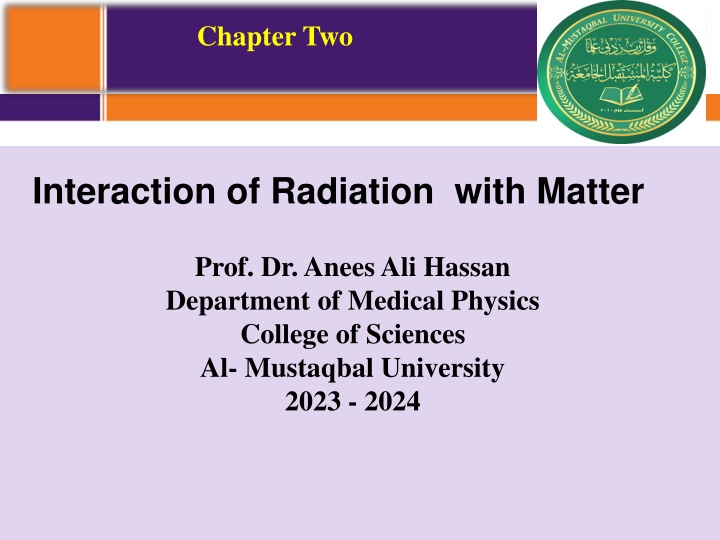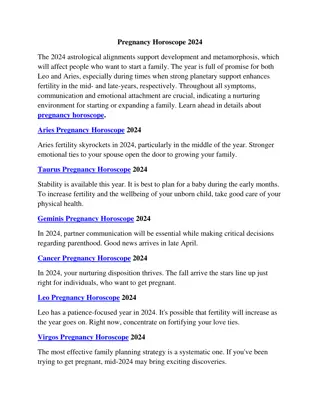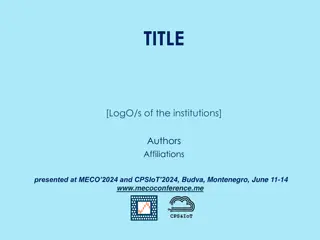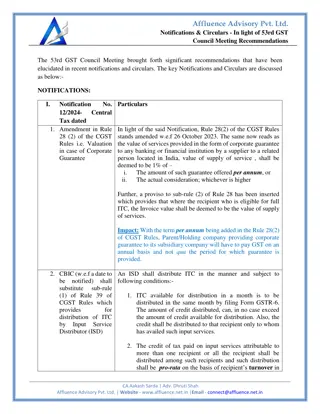
Radiation Interaction with Matter: Overview and Examples
Understand how radiation interacts with matter through heavy and light charged particles, photons, and neutrons. Explore concepts like Coulomb interaction, photoelectric effect, Compton scattering, and more in this insightful lecture by Prof. Dr. Anees Ali Hassan.
Download Presentation

Please find below an Image/Link to download the presentation.
The content on the website is provided AS IS for your information and personal use only. It may not be sold, licensed, or shared on other websites without obtaining consent from the author. If you encounter any issues during the download, it is possible that the publisher has removed the file from their server.
You are allowed to download the files provided on this website for personal or commercial use, subject to the condition that they are used lawfully. All files are the property of their respective owners.
The content on the website is provided AS IS for your information and personal use only. It may not be sold, licensed, or shared on other websites without obtaining consent from the author.
E N D
Presentation Transcript
Chapter Two Interaction of Radiation with Matter Prof. Dr. Anees Ali Hassan Department of Medical Physics College of Sciences Al- Mustaqbal University 2023 - 2024
Contents of the lecture Introduction Interaction of heavy charged particles Interaction of light charged particles o Coulomb interaction o Radiation interaction Interaction of photons o Photoelectric effect o Compton scattering o Pair production Interaction of neutrons Laws of Absorption Problems
Introduction The operation of any radiation detector basically depends on the manner in which the radiation to be detected interacts with the material of the detector itself. Radiation can be classified in order to the charge and mass to the: Heavy charged particles, light charged particles, gamma ray and neutrons.
Interaction of radiation with matter Interaction of heavy charged particles with matter Heavy charged particles, such as the alpha particle and protons, interact with matter primarily through coulomb forces between their positive charge and the negative charge of the orbital electrons within the absorber atoms. Depending on the proximity of the encounter, this impulse may be sufficient either to raise the electron to a higher-lying shell within the absorber atom (excitation) or to remove completely the electron from the atom (ionization).
Interaction of radiation with matter Interaction of heavy charged particles with matter The linear stopping power (S) is defined as the differential energy loss for that particle within the material divided by the corresponding differential path length: S = - dE / dx The range (R) is the distance that the particle can travel inside the material, starting from the source until its kinetic energy becomes zero,
Interaction of radiation with matter Interaction of light particles (electrons) with matter Light charged particles such as the electron and the positron are similar in their interaction as heavy charged particles in terms of the Coulomb effect, but because of the convergence of their mass with the orbital electron, so their path inside the matter means a number of deviations. Therefore, the interaction of light particles with matter is classified into: Coulomb interaction and the radiation interaction. o Coulomb interaction: is the loss of energy by inelastic collisions with an orbital electron, such as when heavy particles interact with matter. When energy is transmitted, it either excited or ionized. The stopping power can be calculated through the equation :
Interaction of radiation with matter o Radiation interaction: In this type of interaction, energy is lost through radiation is called stopping radiation. High-energy electrons may reach a distance close to the inner orbit of the atom (K) as a result of the effect of the Coulomb attraction between the electron and the nucleus. When the electron approaches a distance close to the potential of the nucleus, it deviates from its path, and this deviation leads to the emission of photons whose total energy is part of the energy of the incoming electron. The nucleus tries to stop the electron by the Coulomb force, but the electron suddenly gets acceleration as a result of the electromagnetic field of the nucleus, which lead to the emission of rays is called (Bremsstrahlung). The stopping energy can be calculated by the following equation: The total stopping energy can be expressed as:
Interaction of gamma ray with matter Interaction of gamma ray with matter o Photoelectric effect: The effect of the photoelectric effect is evident for photons with energy ranging from 0.1 to 0.5 MeV. In this process, the incoming photon is absorbed by one of the electrons attached to the nucleus of the atom and gives its energy, and thus the electron is released from the atom with kinetic energy, as in the equation below: ? = ?? + ?? Where: ? = Energy of incident photon. ?? = Binding energy of electron. ?? = Kinetic energy of electron. After an electron is emitted from the atomic orbit, it leaves a hole which is filled by an electron from the outer orbits. After that, the process is accompanied by the emission of continuous x-rays, and this phenomenon is called (Auger effect).
Interaction of gamma ray with matter o Compton scattering:The Compton scattering is evident for photons with energy (0.1 to 10 MeV). The incident (photons) interact with one of the outer orbital electrons of the atom, and transfer part of the energy of the photon to the free electron, so it is liberated from the atom and a photon is emitted with energy less than the energy of the incident photon, and by applying the energy conservation law: ? = ? + ?? Where: ? = Energy of incident photon. ? = Energy of scattered photon. ?? = Kinetic energy of electron. The relation between the incident and scattered photon can expressed as: The kinetic energy of the ejected electron can be calculated:
Interaction of gamma ray with matter Pair production:In this type of interaction, gamma rays are absorbed by matter in the production of an electron-positron pair. If any electron present in negative energy level is given energy equals to or greater than 2 moc2 which equals to 1.022 MeV. The electron will rise from the negative energy level to the positive energy level. The process of pair production usually takes place in the electric field of the nucleus. Energy transfer to the electron and positron takes place, and thus the nucleus conserves energy. ? = ??? ?2+ ????2+ ??? + ???
Interaction of neutrons with matter Neutrons are neutral in charge, so they do not interact with orbital electrons at all, and thus reach the nucleus, cutting the Coulomb barrier without hindrance. The fast neutrons collide with the nuclei of the target material, thus forming the combined nucleus, which is in the maximum excited state. The combined nucleus is eliminated from excitation by one of the following decay channels: Elastic scattering channel Inelastic scattering channel Interaction (n, p) channel. Interaction (n, 2n) channel. Interaction (n, ) channel.
Laws of Absorption: When gamma or X-rays interact, the decrease in the intensity of the rays when they fall on a material is directly proportional to the intensity (I) and the thickness of the material (x), so: ? = ??? ?? Where (?) is the intensity of the rays after passing through the thickness (x) of the material. Half thickness: Thickness of the absorbent material that reduces the number of penetrating particles to half of its original number and is denoted by the symbol ? 1 2. There are two types of absorption coefficient: 1. Linear absorption coefficient (??) its unit ? 1 ?? 1 2. Mass absorption coefficient (??) It is the result of dividing the linear absorption coefficient by the density of the absorbent material, its units??2 ?2 ??. ?
Home Work Example 1: Gamma photon emitted from the cesium source 137Cs, has energy 0.662 eV, was absorbed with the electron in the ground level of the hydrogen atom by the photoelectric interaction. Hydrogen binding energy 13.6 eV, calculate the kinetic energy of the electron? Example 2: Calculate the energy, frequency and wavelength of the scattered photons at an angle = 90 when the energy of the incident photons is 1.173 eV; Calculate the kinetic energy of the outgoing electron? Example 3: Calculate the kinetic energy of the positron resulting from the pair production interaction when the energy of the incident photon is 2.022 eV? Example 4: Calculate the thickness of the water layer that reduces the number of gamma photons to 80% of its original number? Where (?? )water = 0.0706 cm2/g; = 1g/cm3






















